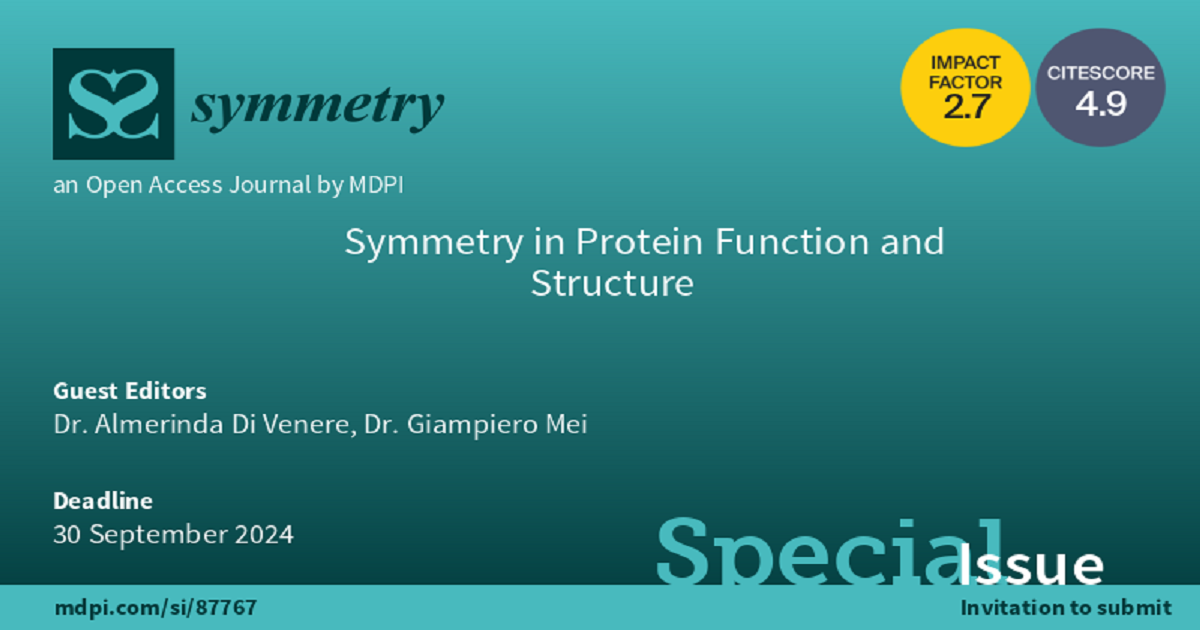Symmetry in Protein Function and Structure
A special issue of Symmetry (ISSN 2073-8994). This special issue belongs to the section "Life Sciences".
Deadline for manuscript submissions: 30 September 2024 | Viewed by 6717

Special Issue Editors
Interests: biophysics
Special Issues, Collections and Topics in MDPI journals
Interests: protein folding; protein-membrane interaction; protein structure-to-function relationship; protein fluorescence
Special Issues, Collections and Topics in MDPI journals
Special Issue Information
Dear Colleagues,
The study of the relationship between protein structure and function is a primary focus in structural biology, with important implications in such diverse fields as biophysics, molecular biology, genetics, biochemistry, protein engineering, and bioinformatics. The stunning diversity of molecular functions performed by naturally evolved proteins is made possible by their finely tuned three-dimensional structures, which are in turn determined by their genetically encoded amino acid sequences. Furthermore, protein structures often have a certain degree of intrinsic symmetry. In fact, the visual inspection of common structural motifs reveals that many of them are symmetric. Therefore, it has been suggested that in early evolution, proteins might have been assembled from multiple identical polypeptide chains. These were then replaced by single polypeptide chains encoding multiple repeats, which fold more reliably and efficiently.
To understand the structure–function paradigm, particularly useful structural information comes from the primary amino acid sequences and the associated tertiary structures. Several recent developments in the analysis of the “protein universe” at the tertiary and quaternary structural level have provided important criteria for understanding the range of family folds that exist and some of the evolutionary relationships associated with them.
Altogether, the great number of protein sequences and structures, spectroscopical techniques, and computational strategies can now support the understanding of the fundamental relationships between protein structure and function.
The aim of this Special Issue of Symmetry is to collect original and review articles on all aspects of protein folding motifs related to protein function.
Dr. Almerinda Di Venere
Prof. Dr. Giampiero Mei
Guest Editors
Manuscript Submission Information
Manuscripts should be submitted online at www.mdpi.com by registering and logging in to this website. Once you are registered, click here to go to the submission form. Manuscripts can be submitted until the deadline. All submissions that pass pre-check are peer-reviewed. Accepted papers will be published continuously in the journal (as soon as accepted) and will be listed together on the special issue website. Research articles, review articles as well as short communications are invited. For planned papers, a title and short abstract (about 100 words) can be sent to the Editorial Office for announcement on this website.
Submitted manuscripts should not have been published previously, nor be under consideration for publication elsewhere (except conference proceedings papers). All manuscripts are thoroughly refereed through a single-blind peer-review process. A guide for authors and other relevant information for submission of manuscripts is available on the Instructions for Authors page. Symmetry is an international peer-reviewed open access monthly journal published by MDPI.
Please visit the Instructions for Authors page before submitting a manuscript. The Article Processing Charge (APC) for publication in this open access journal is 2400 CHF (Swiss Francs). Submitted papers should be well formatted and use good English. Authors may use MDPI's English editing service prior to publication or during author revisions.
Keywords
- protein folding
- protein assembly
- protein symmetry
- structure–function relationship
- misfolding
- computational analysis
- spectroscopy






